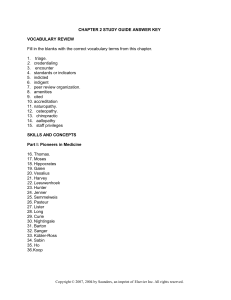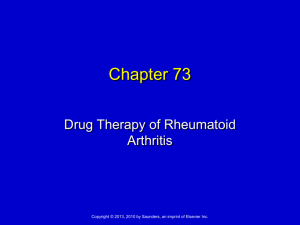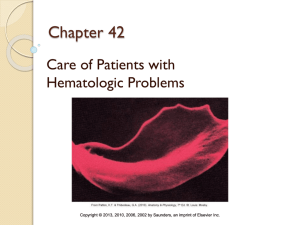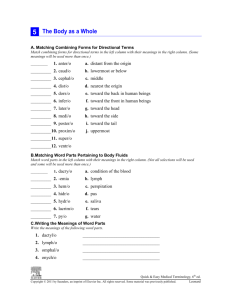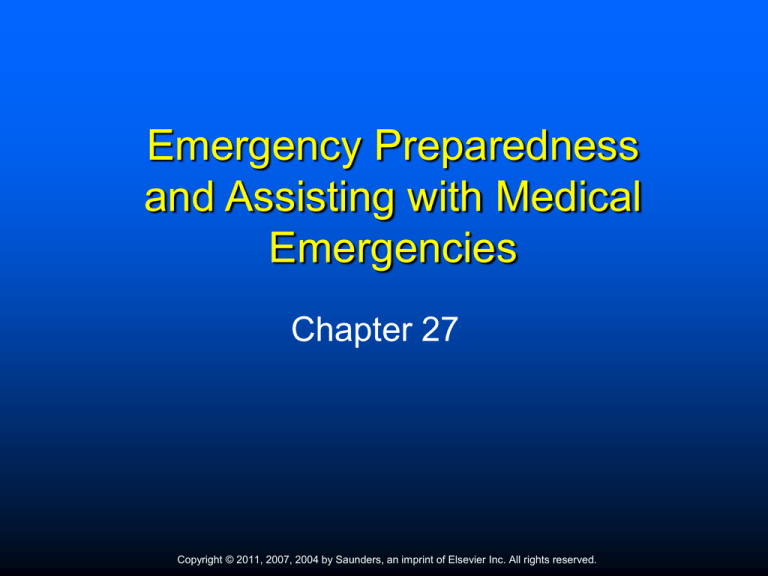
Emergency Preparedness
and Assisting with Medical
Emergencies
Chapter 27
Copyright © 2011, 2007, 2004 by Saunders, an imprint of Elsevier Inc. All rights reserved.
1
Learning Objectives
Define, spell, and pronounce the terms listed
in the vocabulary.
Apply critical thinking skills in performing
patient assessment and care.
Describe patient safety factors in the medical
office environment.
Evaluate the work environment to identify
safe vs. unsafe working conditions.
Identify environmental safety issues in the
healthcare setting.
Copyright © 2011, 2007, 2004 by Saunders, an imprint of Elsevier Inc. All rights reserved.
2
Learning Objectives (cont’d)
Develop environmental, patient and
employee safety plans.
Discuss fire safety issues in a healthcare
environment.
Demonstrate the proper use of a fire
extinguisher.
Describe the fundamental principles for
evacuation of a healthcare setting.
Role-play a mock environmental exposure
event and evacuation of a physician’s office.
Discuss requirements for responding to
hazardous material disposal.
Copyright © 2011, 2007, 2004 by Saunders, an imprint of Elsevier Inc. All rights reserved.
3
Learning Objectives (cont’d)
Define the important features of emergency
preparedness in the ambulatory care setting.
Describe the medical assistant’s role in
emergency response.
Maintain a current list of community
resources for emergency preparedness.
Summarize typical emergency supplies and
equipment.
Demonstrate the use of an automated
external defibrillator.
Copyright © 2011, 2007, 2004 by Saunders, an imprint of Elsevier Inc. All rights reserved.
4
Learning Objectives (cont’d)
Summarize the general rules for managing
emergencies.
Demonstrate screening techniques and
documentation guidelines for ambulatory
care emergencies.
Recognize and respond to life-threatening
emergencies in the ambulatory care setting.
Perform CPR for the professional.
Administer oxygen through a nasal cannula
to a patient in respiratory distress.
Copyright © 2011, 2007, 2004 by Saunders, an imprint of Elsevier Inc. All rights reserved.
5
Learning Objectives (cont’d)
Identify and assist a patient with an
obstructed airway.
Determine appropriate action and
documentation procedures for common
ambulatory care emergencies.
Assist and monitor a patient who has fainted.
Control a hemorrhagic wound.
Apply patient education concepts to medical
emergencies.
Discuss legal and ethical concerns regarding
medical emergencies.
Copyright © 2011, 2007, 2004 by Saunders, an imprint of Elsevier Inc. All rights reserved.
6
The Medical Assistant’s Role in
Patient Safety
Make the facility as accident-proof as possible
Wipe up spills immediately and pick up dropped objects
Keep medications out of sight and away from busy
patient areas
Protect children from sharp objects and potentially toxic
substances
Never leave a seriously ill patient or a restless,
depressed, or unconscious patient unattended
Be vigilant for medication errors
Identify patients before performing a procedure
Perform frequent hand sanitization
Copyright © 2011, 2007, 2004 by Saunders, an imprint of Elsevier Inc. All rights reserved.
7
Features of a Safe Patient Environment
Work as a team to safeguard patients.
Policies and procedures exist to prevent
repeated problems.
Policies and Procedures Manual provide
specific guidelines on how procedures should
be performed.
Facility provides ongoing staff training about
patient safety factors.
Copyright © 2011, 2007, 2004 by Saunders, an imprint of Elsevier Inc. All rights reserved.
8
Discussion – Procedure 27-1
The physician writes an order to be phoned into
the pharmacy for a new patient diagnosed with
depression. You think the order reads “Avinza,
30 mg po bid.” The pharmacist asks you for the
physician’s DEA number because Avinza is a
narcotic analgesic. You ask the physician for
clarification and are told the order was for
Avanza, an antidepressant. Look both
medications up in a drug reference. What could
have happened if the patient was ordered a
powerful narcotic rather than the antidepressant
that the physician intended?
Copyright © 2011, 2007, 2004 by Saunders, an imprint of Elsevier Inc. All rights reserved.
9
OSHA Suggestions For Accident
Prevention
Consistently use proper body mechanics
Constantly check facility for possible tripping
hazards
Store supplies properly
Clean up spills immediately
Use step stool to reach for things
Provide handrails where appropriate
Do not overload electrical outlets
Perform a safety check of the facility routinely
Copyright © 2011, 2007, 2004 by Saunders, an imprint of Elsevier Inc. All rights reserved.
10
Infection Control Procedures
Protect staff from occupational exposure to
bloodborne pathogens while at the same time
safeguarding patients
Manage sharps properly and use safetyengineered sharps devices
Hepatitis B immunization for all employees at
risk of exposure to blood and body fluids
Use latex free supplies as much as possible
MSDS information for chemicals in facility;
store chemicals properly
Perform proper hand hygiene
Copyright © 2011, 2007, 2004 by Saunders, an imprint of Elsevier Inc. All rights reserved.
11
Workplace Violence
Use problem solving techniques, therapeutic
communication and assertive behaviors when
dealing with difficult patients
Train employees on how to identify potentially
violent patients and discuss safe methods for
managing difficult clients
Be on the alert for possible safety hazards in
and around the building such as proper
lighting, limiting access to the facility and
using security systems
Copyright © 2011, 2007, 2004 by Saunders, an imprint of Elsevier Inc. All rights reserved.
12
Procedure 27-3: Managing a
Difficult Patient
You are working at the admissions desk
when an extremely angry patient comes
storming into the office screaming about a
mistake in his bill. Although the facility uses
an outside billing center, you recognize you
should attempt to help the patient and try to
diffuse the situation. Remember: Call 911
immediately and alert any available security if
you or one of your co-workers is being
threatened with violence.
Copyright © 2011, 2007, 2004 by Saunders, an imprint of Elsevier Inc. All rights reserved.
13
Environmental Safety: Fire
Extinguishers (Procedure 27-4)
ABC fire extinguisher is effective against most
common causes
Small extinguishers will empty within 15 seconds
Immediately call 911 if the facility fire is not small
and confined
If the fire is small, there is no heavy smoke and
you have easy access to an exit route then use
the closest fire extinguisher
Do not hesitate to evacuate the facility if you
believe there is any danger to yourself or others
Copyright © 2011, 2007, 2004 by Saunders, an imprint of Elsevier Inc. All rights reserved.
14
Fire Prevention and Management
Properly store potentially flammable chemicals
and supplies
Maintain electrical equipment, cords and
outlets
Immediately disconnect oxygen supplies or
turn off oxygen tanks if fire is suspected
Smoke alarms located throughout the facility,
checked periodically, and replaced as needed
Fire safety equipment is available and current;
fire extinguishers inspected at least annually
Copyright © 2011, 2007, 2004 by Saunders, an imprint of Elsevier Inc. All rights reserved.
15
Fire Prevention and Management
Fire extinguishers located in multiple sites
Immediately call 911 if suspect a fire and
evacuate the facility
Emergency evacuation routes posted
throughout the facility
Emergency exits clearly marked
Designate a meeting place for all personnel
after evacuation to make sure everyone got
out
Copyright © 2011, 2007, 2004 by Saunders, an imprint of Elsevier Inc. All rights reserved.
16
Critical Thinking Application
Cheryl is in the middle of a busy day, patients
are in all of the exam rooms and the waiting
room is full. She walks past the patient
bathroom and smells smoke. She opens the
door and sees smoke and flames coming out
of the waste basket. What should she do?
Write down your response to this scenario
and share it with your classmates.
Copyright © 2011, 2007, 2004 by Saunders, an imprint of Elsevier Inc. All rights reserved.
17
Facility Evacuation Plan
Emergency action coordinator in charge
Coordinator manages emergency at the facility as
well as works with community emergency services
Exit doors must be clearly marked, well lit, and
wide enough for everyone to evacuate
Identify any hazardous areas to avoid during
evacuation
Provide assistance for employees and patients
with special needs
Staff member clears facility, shuts fire doors, etc.,
before being last to leave
Assist co-workers or patients with special needs
Copyright © 2011, 2007, 2004 by Saunders, an imprint of Elsevier Inc. All rights reserved.
18
Procedure 27-5
Role-play with your lab group the following scenario: The
building next door to the physician’s office where you work is
on fire. One member of the group is the designated
emergency action coordinator, two individuals are
responsible for helping patients with special needs out of the
facility, and one person is designated to be the last to leave
after the building is clear. In a community emergency
situation, certain staff members may de designated to
provide immediate assistance to survivors. Two medical
assistants are sent to help with fire victims. How could
medical assistants help in this situation? After the evacuation
is complete, meet in a designated spot to discuss the
process and see if there are any areas in which the
evacuation plan could be improved. Document the steps
taken throughout the mock environmental event.
Copyright © 2011, 2007, 2004 by Saunders, an imprint of Elsevier Inc. All rights reserved.
19
Hazardous Waste Disposal
OSHA regulated waste - contaminated items
that might release blood or other potentially
infectious material; contaminated supplies that
are caked with infectious material;
contaminated sharps; and waste products that
contain blood or other potentially infectious
materials
Healthcare facilities must make special
arrangements for biohazard waste disposal
Frequently costs as much as 10 times more
than regular garbage disposal
Copyright © 2011, 2007, 2004 by Saunders, an imprint of Elsevier Inc. All rights reserved.
20
Proper Disposal of Hazardous Waste
Place signs on or near the biohazard
container to identify its purpose and what
materials should be deposited there
Containers should be covered and have a
foot peddle to operate opening and closing
Place regular garbage container next to a
biohazard container so staff only uses
biohazard bags as needed
Place only sharps in sharps containers;
gauze, bandages, etc., belong in
contaminated waste container; noninfectious
packaging material and other items belong in
regular trash
Copyright © 2011, 2007, 2004 by Saunders, an imprint of Elsevier Inc. All rights reserved.
21
Community Emergency Preparedness
Ambulatory care centers and hospitals may be
the first to recognize and initiate a response to
a community emergency
Standard Precautions should be implemented
immediately
Access communication network to notify local
and state health departments and perhaps
federal officials of possible community
emergency
Your employer may participate in an annual
community disaster preparedness drill
Copyright © 2011, 2007, 2004 by Saunders, an imprint of Elsevier Inc. All rights reserved.
22
Emergency Planning
Staff members should discuss possible
emergencies that may occur and have an
emergency action plan for rapid, systematic
intervention.
Every healthcare facility should have a standard
policy with specific procedures for emergency
situations.
With several employees, each should be
assigned specific duties.
Copyright © 2011, 2007, 2004 by Saunders, an imprint of Elsevier Inc. All rights reserved.
23
Local Emergency Management
Authority (LEMA)
LEMA coordinates police, fire, emergency
medical services, public health and area
healthcare response to community-wide
emergencies
Responsible for developing an all-hazards
response plan that would be appropriate for
any community emergency
Local officials would turn to state, regional or
federal officials for assistance as needed
Copyright © 2011, 2007, 2004 by Saunders, an imprint of Elsevier Inc. All rights reserved.
24
Emergency Preparedness Plans
Evacuate facility as needed
Protect patient medical record; have backup
systems or flash drives
If there is a community emergency, provide
care within the facility
Coordinate services between the ambulatory
facility and other local healthcare systems
Supply staff and supplies as needed
Maintain current phone trees to notify staff
Educate patients on emergency
preparedness
Copyright © 2011, 2007, 2004 by Saunders, an imprint of Elsevier Inc. All rights reserved.
25
Critical Thinking Application
There is a chemical plant located about 3
blocks from Dr. Bendt’s office. The office staff
is brainstorming ideas of what should be
done if there is an accident at the plant.
Based on what you have learned so far about
emergency preparedness, what do you think
should be included in the office’s emergency
plan?
Copyright © 2011, 2007, 2004 by Saunders, an imprint of Elsevier Inc. All rights reserved.
26
Community Emergency Services
Most communities have an emergency
medical services (EMS) system or 911
service that is available 24 hours a day
Poison control centers are ready to provide
emergency information for treating victims of
poisonings
Every healthcare facility should post a list of
local emergency numbers that is in plain sight
and known to all office personnel.
Include on the list the local EMS system,
poison control center, ambulance and rescue
squad, fire department, and police
department numbers
Copyright © 2011, 2007, 2004 by Saunders, an imprint of Elsevier Inc. All rights reserved.
27
Telephone Numbers for Community
Emergency Preparedness
Local hospital numbers including the
Emergency Room, Infection Control Officer,
administration contacts, and Public Affairs
office
Poison Control
Fire and police departments
EMS
Local and state Health Department
CDC Emergency Response Office:
770/448-7100
Complete Procedure 27-6
Copyright © 2011, 2007, 2004 by Saunders, an imprint of Elsevier Inc. All rights reserved.
28
Infection Control and Bioterrorism
Sanitize hands routinely
Wear disposable gloves
Use masks/eye protection or face shields if there
is potential for splashing
Wear gowns to protect skin and clothes as
needed; remove them promptly and wash hands
to prevent transmission of infectious material
Sanitize, disinfect, and sterilize equipment,
supplies, and environmental surfaces
Dispose of contaminated waste in appropriate
biohazard containers
Copyright © 2011, 2007, 2004 by Saunders, an imprint of Elsevier Inc. All rights reserved.
29
CDC Recommendations
The CDC recommends all healthcare facilities be
aware of possible agents of bioterrorism including
anthrax, botulism, plague, and smallpox.
The physician will diagnose and report any
suspected cases.
The medical assistant may be involved in patient
care and participate in prevention of the spread of
infection.
Standard Precautions should be implemented with
all patients regardless of their diagnosis or
possible infection status.
Copyright © 2011, 2007, 2004 by Saunders, an imprint of Elsevier Inc. All rights reserved.
30
Psychological Aspects of Emergencies
Provide fact sheets for employees and
patients to help them understand the dangers
of certain emergencies and encourage
employee participation in disaster drills.
Plan in advance for effective communication.
Explain emergency situations to patients and
healthcare workers; offer immediate evaluation
and treatment of an infectious outbreak.
Treat acute anxiety with reassurance and
explanation; physician may order medication if
reassurance does not relieve acute anxiety;
provide follow-up counseling as needed for
employees.
Copyright © 2011, 2007, 2004 by Saunders, an imprint of Elsevier Inc. All rights reserved.
31
Role of Medical Assistants
in an Emergency
Provide emergency first aid
Conduct patient interviews in an empathetic
manner using therapeutic communication
tools
Assist with mass vaccination efforts or
antibiotic distribution
Documentation and electronic health record
management
Follow Standard Precaution procedures
Patient education
Phlebotomy and laboratory procedures
Copyright © 2011, 2007, 2004 by Saunders, an imprint of Elsevier Inc. All rights reserved.
32
Supplies and Equipment
for Emergencies
Emergency supplies
Crash cart
Stored in easily accessible area
Check expiration dates
Restock supplies
Emergency medications
Copyright © 2011, 2007, 2004 by Saunders, an imprint of Elsevier Inc. All rights reserved.
33
Emergency Medications
Epinephrine is a vasoconstrictor; controls
hemorrhage, relaxes bronchioles, treatment of acute
anaphylactic reaction
Atropine decreases secretions, increases respiration
and heart rate, smooth-muscle relaxant
Digoxin is a cardiac drug; treats arrhythmias and
CHF
Nitroglycerin is a vasodilator; relieves angina
Lidocaine IV to treat cardiac arrhythmia and a local
anesthetic
Sodium bicarbonate corrects metabolic acidosis that
occurs after cardiac arrest
Copyright © 2011, 2007, 2004 by Saunders, an imprint of Elsevier Inc. All rights reserved.
34
Emergency Medications (cont’d)
Syrup of ipecac causes vomiting
Activated charcoal is an antidote swallowed
to absorb ingested poisons
Narcan is a narcotic antidote administered IV
for narcotic drug overdoses; raises BP and
increases respiratory rate
Antihistamines for the treatment of allergic
reactions and anaphylaxis need to be
available to treat potential allergic responses
including Benadryl for minor reactions and
Solu-Medrol, a corticosteroid for anaphylaxis
Copyright © 2011, 2007, 2004 by Saunders, an imprint of Elsevier Inc. All rights reserved.
35
Defibrillators
Indicated during ventricular fibrillation
Send electrical current through the myocardium
by paddles applied to chest
Automated external defibrillator (AED)
Copyright © 2011, 2007, 2004 by Saunders, an imprint of Elsevier Inc. All rights reserved.
36
Example Defibrillator
From Aehlert B: Mosby’s comprehensive pediatric emergency care, St Louis, 2005, Mosby.
Copyright © 2011, 2007, 2004 by Saunders, an imprint of Elsevier Inc. All rights reserved.
37
AED Precautions
Avoid contact with metal during defibrillation.
Do not use on children under age of 8,
or <55 lb.
All clothing must be removed; pads are applied
directly to skin.
Patient must be on a dry surface, chest dry.
Apply AED pads at least 1 inch away from
implants to avoid interference.
Copyright © 2011, 2007, 2004 by Saunders, an imprint of Elsevier Inc. All rights reserved.
38
General Rules for Emergencies
1.
2.
3.
4.
Stay calm
Assess the situation to determine nature of
the emergency.
Obtain as much information as possible to
determine the appropriate action.
Immediately refer any concerns to the office
supervisor or physician.
Copyright © 2011, 2007, 2004 by Saunders, an imprint of Elsevier Inc. All rights reserved.
39
Telephone Screening (Table 27-1)
If the patient’s situation is life-threatening,
activate EMS/911.
Record name of caller, patient, location, phone
number.
Ask for help if unsure how to handle.
Notify ER.
Obtain information regarding patient’s condition.
Detail regarding what has been done for patient.
Document.
Copyright © 2011, 2007, 2004 by Saunders, an imprint of Elsevier Inc. All rights reserved.
40
Management of On-Site Emergencies
Implement OSHA standard precautions.
Activate EMS, stay with patient.
Document all details regarding the incident in
patient’s chart.
Copyright © 2011, 2007, 2004 by Saunders, an imprint of Elsevier Inc. All rights reserved.
41
Documentation of On-Site Emergency
Patient’s name, address, age, and health
insurance information
Allergies, current medications, and pertinent
health history
Name and relationship of any person with
patient
Vital signs and chief complaint
Sequence of events, beginning with how
problem occurred, any changes in the
condition, and any observations
Details regarding procedures or treatments
performed
Copyright © 2011, 2007, 2004 by Saunders, an imprint of Elsevier Inc. All rights reserved.
42
Life-Threatening Emergencies
Nonresponsive patient
Notify physician immediately, activate EMS.
Assess respirations.
Position patient in supine position, apply
head-tilt–chin-lift.
Stabilize neck.
Assess pulse.
Perform CPR as needed.
Copyright © 2011, 2007, 2004 by Saunders, an imprint of Elsevier Inc. All rights reserved.
43
Cardiac Emergencies
Report symptoms to clinician, activate EMS.
Use wheelchair to move patient.
Use Fowler’s position.
Keep patient quiet and warm.
Loosen tight clothing.
Take vital signs, start O2.
Gather crash cart.
Obtain information from patient.
Copyright © 2011, 2007, 2004 by Saunders, an imprint of Elsevier Inc. All rights reserved.
44
Signs of a Heart Attack
Usually caused by a blockage of the coronary arteries that
decreases the amount of blood being delivered to the
myocardium
Most common signal of a heart attack is an uncomfortable
pressure, squeezing, fullness, or pain in the center of the
chest; may spread to the shoulder, neck, jaw, or arms
Other symptoms include diaphoresis, nausea or
indigestion, shortness of breath (SOB), cold and clammy
skin, and general malaise
If these signs persist longer than 5 minutes, the patient
should activate EMS
Most people deny that the problem is serious
Copyright © 2011, 2007, 2004 by Saunders, an imprint of Elsevier Inc. All rights reserved.
45
MI Signs and Symptoms in Women
Include a combination of the following:
Back pain or aching and throbbing in biceps or
forearms
Shortness of breath
Clammy perspiration
Vertigo—unexplained lightheadedness or syncopal
episodes
Edema—especially of the ankles and/or lower legs
Fluttering heartbeat or tachycardia
Gastric upset
Feeling of heaviness or fullness in the mediastinum
Copyright © 2011, 2007, 2004 by Saunders, an imprint of Elsevier Inc. All rights reserved.
46
Choking
Usually caused by foreign objects
Universal sign of choking:
Refer to Procedure 27-11 for how to respond
to an adult with an obstructed airway
Copyright © 2011, 2007, 2004 by Saunders, an imprint of Elsevier Inc. All rights reserved.
47
Cerebrovascular Accident (Stroke)
Disorder of the cerebral blood vessels that
results in an impairment of the blood supply to
part of the brain.
TIA – temporary neurological indicators of
problem with blood supply to brain
Signs and symptoms: unconsciousness,
paralysis, dyspnea, dysphagia, loss of bladder
control, unequal pupil size, slurred speech
May be treated with thrombolytics if diagnosed
soon after incident occurs
Copyright © 2011, 2007, 2004 by Saunders, an imprint of Elsevier Inc. All rights reserved.
48
Recovery Position
Place the patient’s arm that is farthest from
you along side and above the head; place the
other arm across the chest.
Bend the leg that is closest to you and after
placing one arm under the patient’s head and
shoulder and the other hand on the flexed
knee, roll the patient away from you while you
stabilize the head and neck.
Copyright © 2011, 2007, 2004 by Saunders, an imprint of Elsevier Inc. All rights reserved.
49
Shock
Anaphylactic
Insulin
Psychogenic or mental
Hypovolemic or hemorrhagic
Cardiogenic
Neurogenic
Septic
Copyright © 2011, 2007, 2004 by Saunders, an imprint of Elsevier Inc. All rights reserved.
50
Common Office Emergencies
Fainting
Patient appears pale; may feel cold weak, dizzy, or
nauseated; may have numbness
Supine position, loosen clothes
Refer to Procedure 27-6
Poisoning
Patient may have burns on the hands and mouth,
stains on clothing, changes in skin color, nausea,
stomach cramps, shallow breathing, convulsions,
heavy perspiration, dizziness, and unconsciousness
Copyright © 2011, 2007, 2004 by Saunders, an imprint of Elsevier Inc. All rights reserved.
51
Questions if Poisoning Reported
Name, weight, and age of the victim
Name of poison taken and any information on
label
How much was taken
How long ago the poison was ingested
Whether vomiting has occurred
Any pertinent symptoms, such as difficulty
breathing or an altered state of
consciousness
Any first aid given
Copyright © 2011, 2007, 2004 by Saunders, an imprint of Elsevier Inc. All rights reserved.
52
Animal Bites
Rabies, tetanus, and local skin infections
Clean area
Tetanus vaccination
Rabies vaccination – 5 injections started as
soon as possible
Copyright © 2011, 2007, 2004 by Saunders, an imprint of Elsevier Inc. All rights reserved.
53
Insect Bites and Stings
Typical symptoms
Inflammation, itching, edema
Watch for systemic allergic reaction
Treatments
Epinephrine, oxygen, corticosteroids
Apply ice
Calamine lotion, creams
EpiPen for anaphylactic reactions
Copyright © 2011, 2007, 2004 by Saunders, an imprint of Elsevier Inc. All rights reserved.
54
Asthma Attacks
Symptoms:
Wheezing, coughing, tightness in chest, SOB
Bronchodilators
May be advised to ER
Copyright © 2011, 2007, 2004 by Saunders, an imprint of Elsevier Inc. All rights reserved.
55
Seizures
Idiopathic; related to trauma, injury, or metabolic
alterations; febrile seizures.
Clear everything away; do not place anything in
patient’s mouth.
Do not hold patient down.
Place patient in recovery position after seizure.
Copyright © 2011, 2007, 2004 by Saunders, an imprint of Elsevier Inc. All rights reserved.
56
Seizure Management
Call 911 for emergency assistance in any of the
following situations:
Has not regained consciousness within 10 to
15 minutes
Seizure does not stop within a few minutes
Second seizure begins immediately after initial
one
Patient is pregnant
Signs of head trauma present
Patient is a known diabetic
Seizure was triggered by a high fever in a child
Copyright © 2011, 2007, 2004 by Saunders, an imprint of Elsevier Inc. All rights reserved.
57
Abdominal Pain
Keep the patient warm and quiet.
Have an emesis basin available.
Administer nothing by mouth.
Do not apply heat, unless instructed.
Check and record vital signs.
Follow physician’s orders.
Copyright © 2011, 2007, 2004 by Saunders, an imprint of Elsevier Inc. All rights reserved.
58
Sprains and Strains
Sprains: tears of the ligaments
Strains: injuries to a muscle and tendon
Treatment: elevate the affected area, applying
mild compression, and ice
Copyright © 2011, 2007, 2004 by Saunders, an imprint of Elsevier Inc. All rights reserved.
59
Fractures
Make patient comfortable
Treatment: splinting, elevations of affected
extremity, application of ice, control of bleeding
Copyright © 2011, 2007, 2004 by Saunders, an imprint of Elsevier Inc. All rights reserved.
60
Burns
Result from flame, heat, scalds, electricity,
chemicals, or radiation
Chemical burns - immediately remove all
clothing that may have come into contact with
the chemical and flood the affected area with
running water
Rule of Nines
Copyright © 2011, 2007, 2004 by Saunders, an imprint of Elsevier Inc. All rights reserved.
61
Rule of Nines Classification of Burns
Copyright © 2011, 2007, 2004 by Saunders, an imprint of Elsevier Inc. All rights reserved.
62
Tissue Injuries
Contusion – closed wound; no evidence of
injury to skin; caused by blunt trauma; a
painful bruise but skin intact
Abrasion – surface of skin scraped
Laceration – deeper, more jagged wound;
may be additional tissue damage surrounding
it; may need to be surgically repaired
Puncture – object forced into the body;
stabilize the object as much as possible with
rolled up material before transporting
Avulsion – tissue or body part torn away
Copyright © 2011, 2007, 2004 by Saunders, an imprint of Elsevier Inc. All rights reserved.
63
Lacerations
Apply gloves, notify physician.
Covered area with sterile dressing.
Clean area.
Possible tetanus booster.
Complete wound closure.
Sterile dressing.
Copyright © 2011, 2007, 2004 by Saunders, an imprint of Elsevier Inc. All rights reserved.
64
Epistaxis
Caused by:
Injury, disease, HTN, strenuous activity, high
altitudes, exposure to cold, overuse of anticoagulant
Treatment
Mild to moderate: apply direct pressure
If bleeding is bilateral and continuous: EMS
Copyright © 2011, 2007, 2004 by Saunders, an imprint of Elsevier Inc. All rights reserved.
65
Head Injuries
Dizziness, headache, mental confusion,
memory loss
Vomiting, loss of bladder and bowel control,
bleeding, changes to pupils
Stabilize neck, NPO, watch pupils, obtain vital
signs
Copyright © 2011, 2007, 2004 by Saunders, an imprint of Elsevier Inc. All rights reserved.
66
Foreign Bodies in the Eye
Tell patient not to touch the eye.
Place patient in darkened room.
Apply wet compresses.
Perform eye irrigation as ordered.
Copyright © 2011, 2007, 2004 by Saunders, an imprint of Elsevier Inc. All rights reserved.
67
Heat and Cold Injuries
Heat exhaustion
Heat stroke
Frostbite
Hypothermia
Copyright © 2011, 2007, 2004 by Saunders, an imprint of Elsevier Inc. All rights reserved.
68
Dehydration
Patient excretes more water than is taken in
Symptoms:
Vertigo, dark yellow urine, or no urine output,
extreme thirst, lethargy, confusion, or muscle cramps
Treatment:
Replace fluids, ER
Copyright © 2011, 2007, 2004 by Saunders, an imprint of Elsevier Inc. All rights reserved.
69
Diabetic Emergencies
Hyperglycemia
Diabetic coma
Hypoglycemia
Insulin shock
Copyright © 2011, 2007, 2004 by Saunders, an imprint of Elsevier Inc. All rights reserved.
70
Patient Education
The medical assistant must remain calm,
assess the situation, call for help, and be
prepared to administer appropriate first aid
intervention.
Provide brochures regarding home safety.
Instruct patients to post emergency numbers.
“Childproof” homes.
Copyright © 2011, 2007, 2004 by Saunders, an imprint of Elsevier Inc. All rights reserved.
71
Legal Issues
Good Samaritan laws protect individuals who provide
medical assistance at the scene of an accident
Statutes vary greatly from state to state
Not legally obligated to give emergency care at the
site of an accident
Legal liability limited to gross neglect of the victim or
willfully causing further injury to the victim
Are protected as long as you work within your scope
of competence
Are only in effect at the site of an emergency, not at
your place of employment
Copyright © 2011, 2007, 2004 by Saunders, an imprint of Elsevier Inc. All rights reserved.
72





